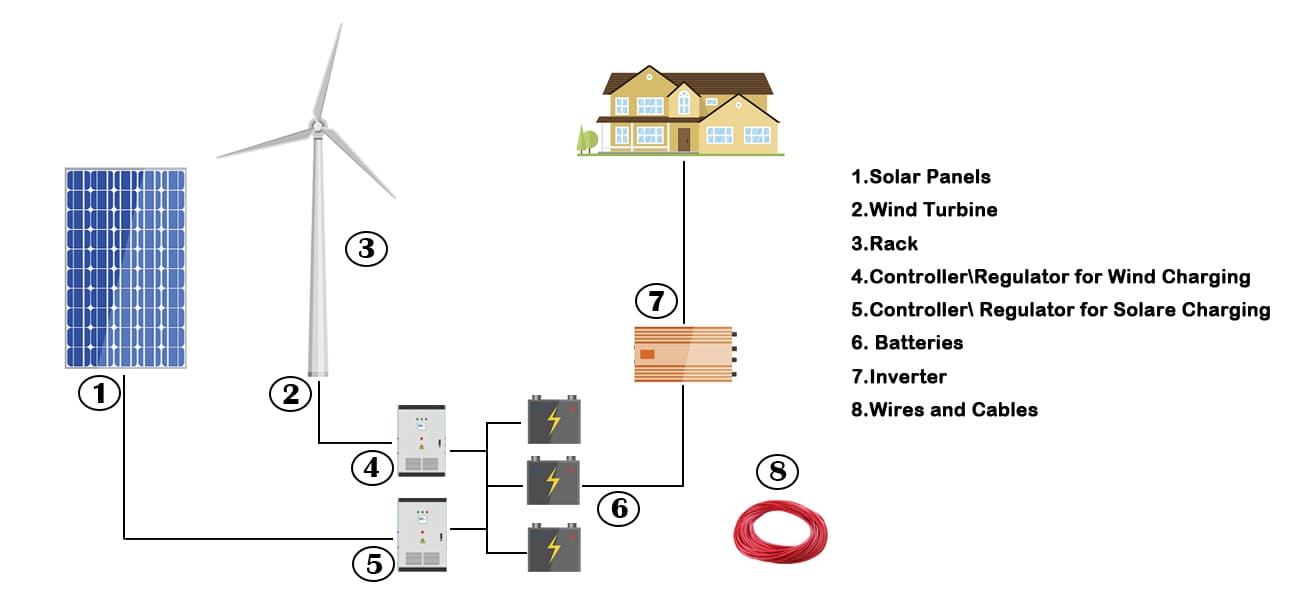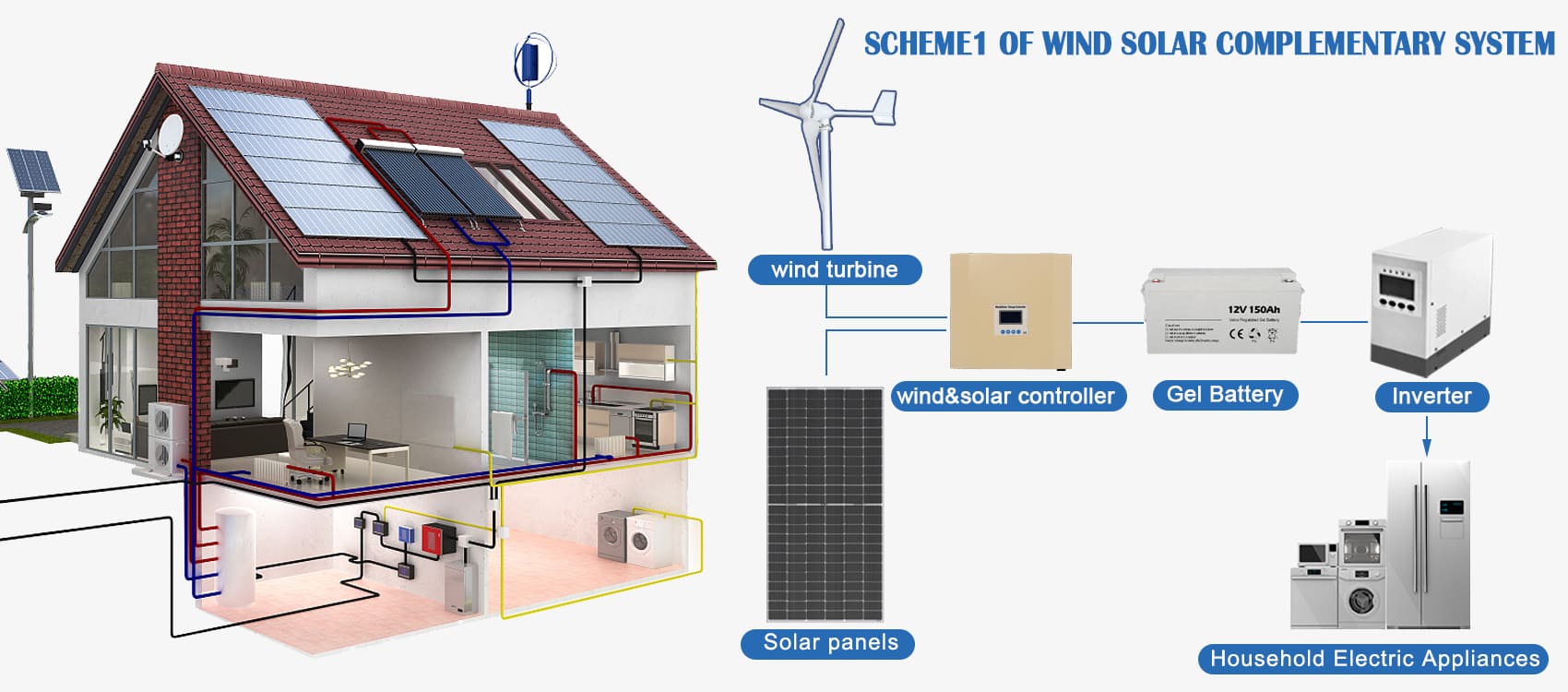1、What is a hybrid wind and solar system?
A solar-wind hybrid system combines solar power generation and wind power generation, two renewable energy technologies, to jointly supply power to users. Such systems typically include multiple components such as solar panels, wind turbines, battery energy storage devices, and power conversion equipment.
Solar power and wind power each have their own advantages and disadvantages. Solar power relies on sunshine and is limited during rain or night, while wind power requires specific wind speeds. The hybrid system maximizes their complementarity, utilizing their strengths in different weather conditions, ensuring stable and reliable power supply.

2. Working principle of solar-wind energy hybrid system
The working principle of the solar-wind energy hybrid system is relatively simple and can be summarized as the following steps:
Solar panels convert sunlight into direct current electricity, and wind turbines convert wind energy into alternating current electricity.
Power conversion equipment converts direct current and alternating current into alternating current that can be used by users.
Battery energy storage stores excess electricity and supplements power during high demand. The control device adjusts system components based on real-time factors, ensuring stable and reliable power supply.
3. Benefits of Solar-Wind Hybrid Systems
Improve energy efficiency
The solar-wind hybrid system combines the advantages of two renewable energy sources, making better use of natural resources and improving overall energy efficiency. During the sunny day, the solar panels can exert maximum power; while at night or in rainy weather, the wind turbine can continuously provide power to the system. The complementarity of the two energy sources makes the system’s energy utilization more fully and stable.
Improve power supply reliability
The traditional single energy power generation system is greatly affected by natural conditions and has low power supply reliability. The solar and wind energy hybrid system has stronger anti-interference ability. Even if one energy source cannot generate electricity, the other energy source can ensure the power supply. This greatly improves the power supply reliability of the system and provides users with more stable power services.
Reduce carbon emissions
Clean energy from solar and wind power eliminates the need for fossil fuel combustion, significantly reducing carbon emissions. This aids in mitigating global warming and achieving sustainable development goals for society.
Reduce operating costs
The operating costs of solar-wind hybrid systems are much lower than traditional fossil fuel power generation. Once built, the system’s operation and maintenance costs are low and there is no need for frequent refueling. At the same time, with the continuous advancement of renewable energy technology, the initial investment cost of such systems is gradually decreasing. In the long run, the solar-wind hybrid system is undoubtedly a more economical way to generate electricity.
Flexible
Solar and wind energy hybrid systems have strong flexibility and adaptability. The system can automatically adjust the working status of each component according to changes in actual demand to ensure power supply. At the same time, this kind of system can be optimized and designed according to the natural conditions of different regions to better meet the needs of local users.
4. Key technologies of solar and wind hybrid systems
To achieve efficient operation of solar and wind hybrid systems, several key technologies are required:
High-efficiency solar cells and wind turbines
Solar cells and wind turbines are crucial components with their efficiency impacting the overall system performance. Advancements in technology have increased their conversion efficiency, paving the way for widespread adoption of solar-wind hybrid systems.
Advanced power conversion technology
Power conversion equipment is responsible for converting direct current and alternating current to ensure that the power output meets user needs. Advanced power conversion technology, such as high-frequency switching power supply technology, inverter technology, etc., can improve power conversion efficiency and reduce system energy consumption.
High performance battery energy storage technology
Battery energy storage devices are used to store excess power generated by the system and provide supplementation during peak demand. The development of advanced energy storage technologies such as lithium batteries and sodium-sulfur batteries has greatly improved the energy density and cycle life of batteries and enhanced the energy storage capacity of the system.
Intelligent system control technology
System control devices are the key to realizing the automated operation of solar and wind hybrid systems. An intelligent control system based on the Internet of Things, big data and other technologies can monitor the working status of each component in real time and automatically adjust system parameters according to actual needs to ensure the stability and reliability of power supply.
With the continuous advancement of the above-mentioned key technologies, solar and wind energy hybrid systems will surely usher in broader development prospects.
5. Solar and wind hybrid systems – the future of renewable energy
Distributed power supply
Ideal for remote and off-grid areas, providing reliable power to residents. Environmentally friendly and energy-saving compared to diesel generators, with lower operating costs. Aligns with the decentralized and intelligent power system trend.
Microgrid construction
Solar and wind energy hybrid systems can be used as an important part of microgrid construction. Microgrid is a small-scale, autonomously operating regional power system that can realize intelligent coordinated control of distributed power supplies, energy storage devices, loads, etc. The solar and wind energy hybrid system can provide a stable power source for the microgrid and greatly improve the power supply reliability of the microgrid.
Industrial and commercial applications
For some large power facilities such as factories, shopping malls, and office buildings, solar and wind energy hybrid systems are also a good choice. The system ensures reliable power supply, reduces carbon emissions, and lowers operating costs. As the demand for clean energy rises, solar-wind hybrid systems find broad applications in industrial and commercial sectors.
Electric Vehicle Charging:
With the popularization of electric vehicles, wind and solar hybrid systems provide reliable and clean power support for charging infrastructure to meet the growing demand for various types of electricity,The market prospects are optimistic.
Conclusion:
Solar-wind energy hybrid systems will play a vital role in future power supply with the continuous advancement of technology and cost reduction, as well as future environmental protection policies and global carbon emission strategic plans.

